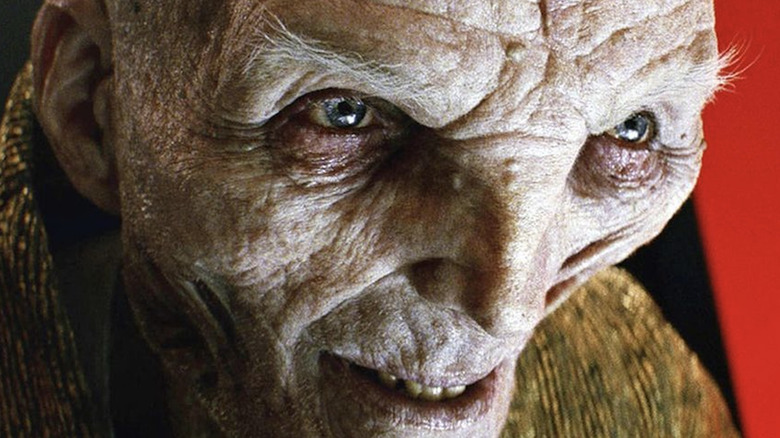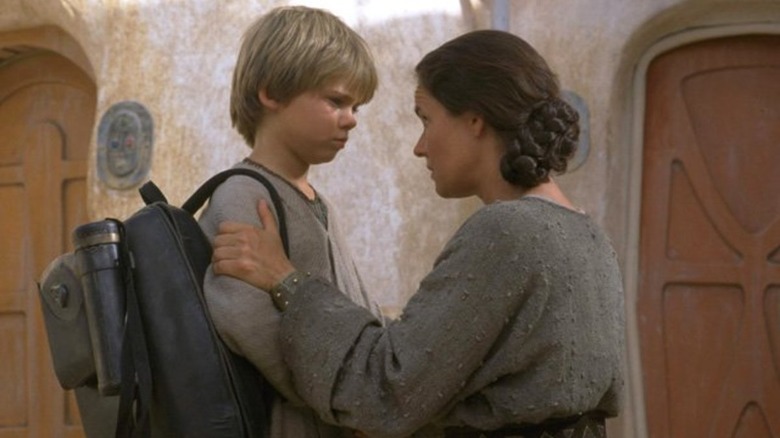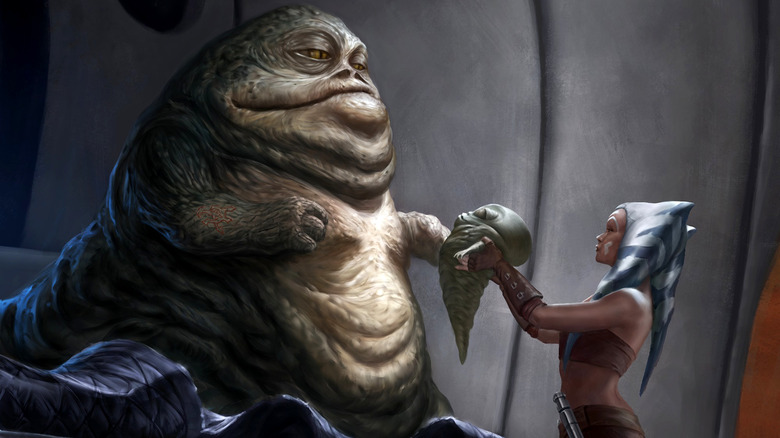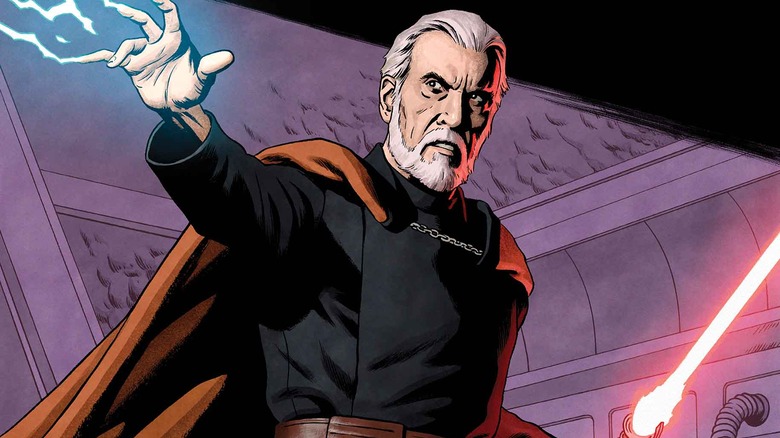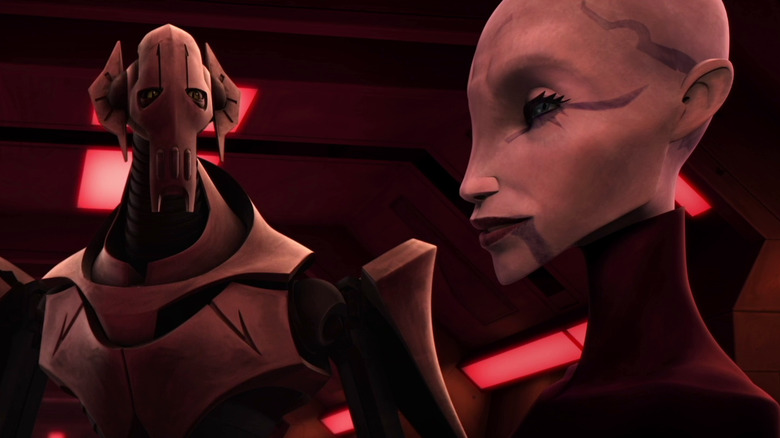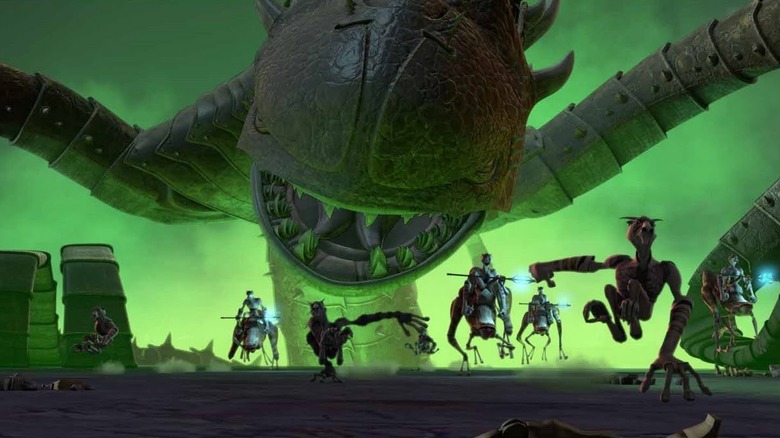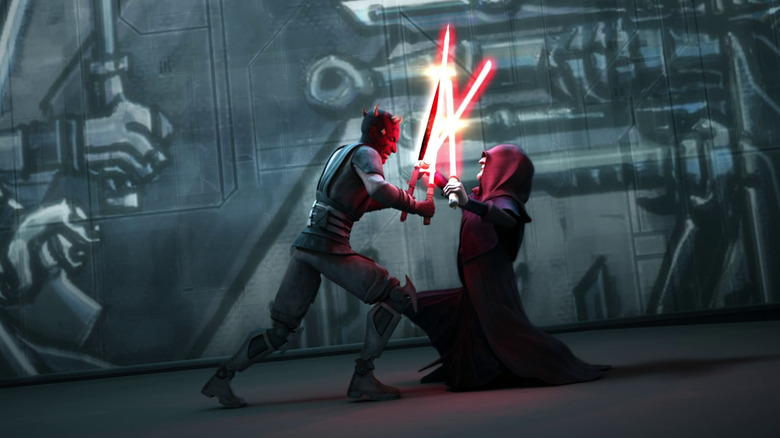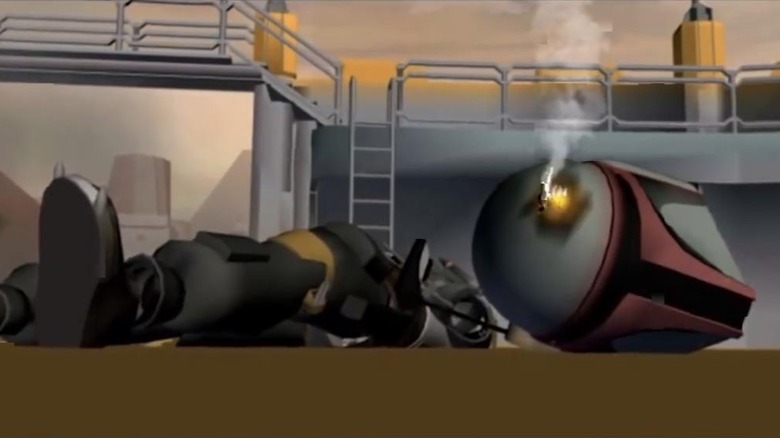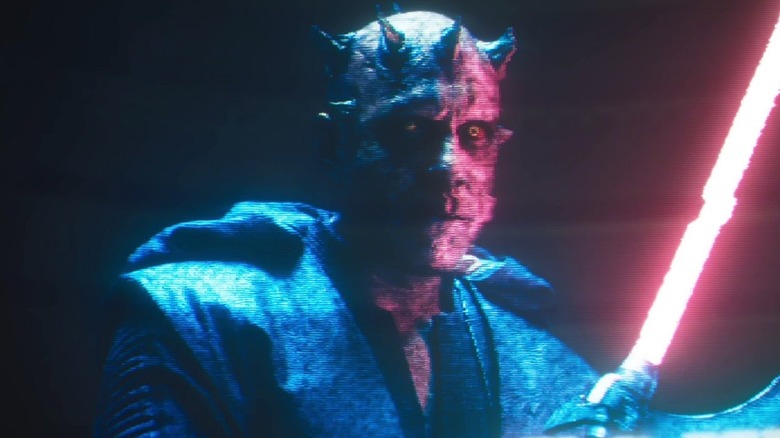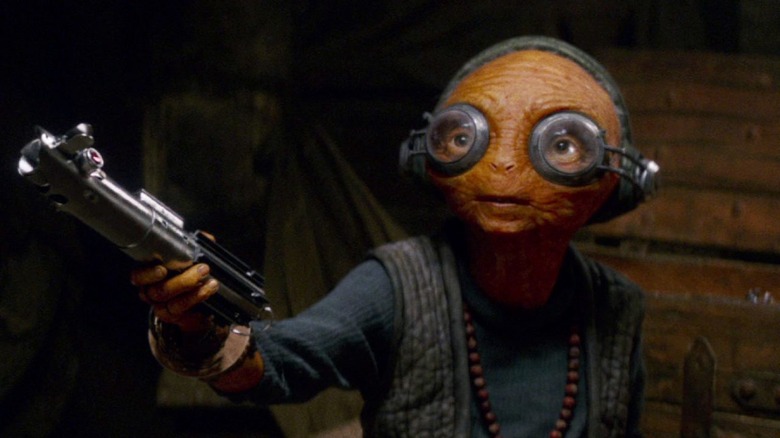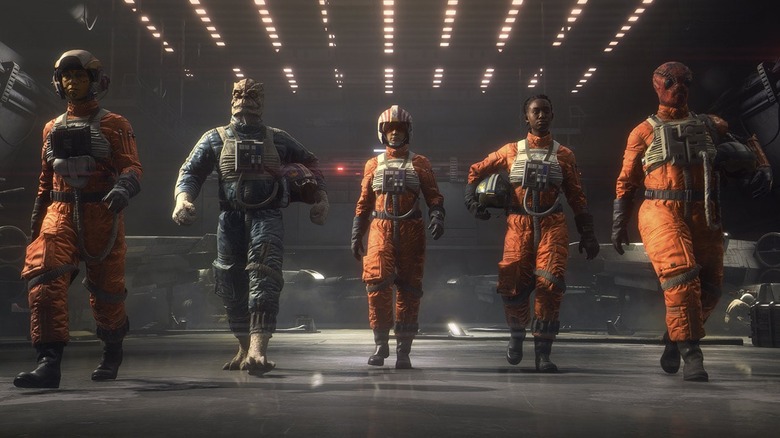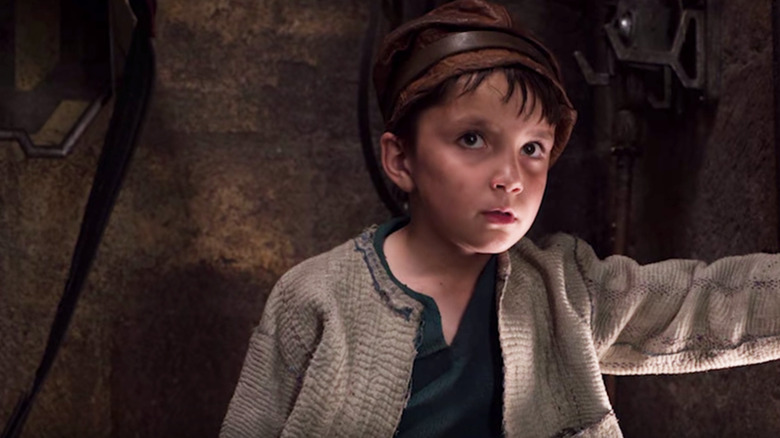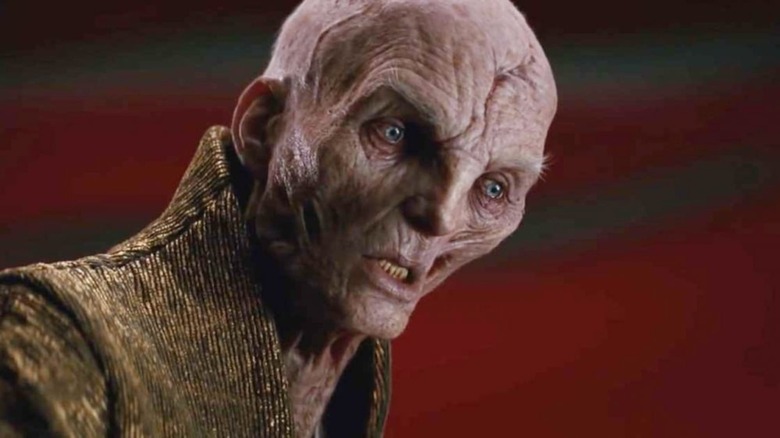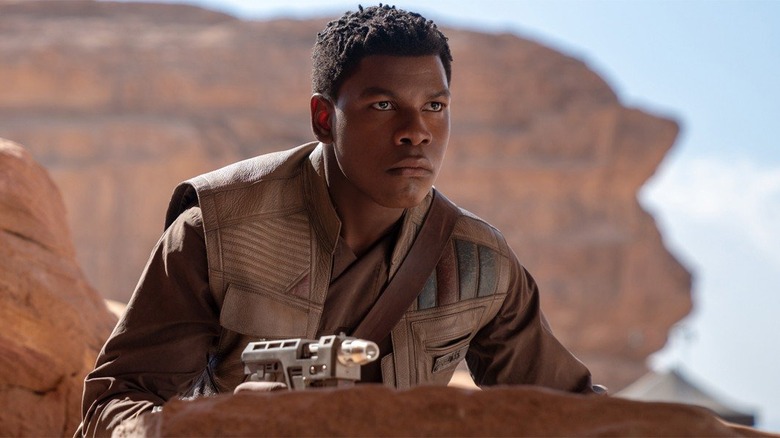Star Wars Storylines That Disappeared Without Explanation
Quite possibly the largest entertainment franchise on the planet, George Lucas' "Star Wars" has told countless stories across its films, television series, books, comics, and video games. With all those stories from numerous creators, told across two different continuities, fans shouldn't be too surprised when they come across some that are never resolved — a misstep, perhaps, down a path that was eventually paved over and left unattended.
There are numerous examples of this happening in the pre-Disney "Legends" canon. BioWare and Obsidion's famous "Knights of the Old Republic" video games never received the third and final entry in its trilogy. The "Republic/Imperial Commando" book series by Karen Traviss never published its final installment because an episode of "The Clone Wars" rewrote the piece of canon it had been based on.
This type of thing, though regrettable, was to be expected during this past decade of transition, and was likely a major reason why Disney discarded the old "Legends," instituting its story group to oversee a new canon and maintain continuity among the many "Star Wars" projects. Even in the Disney age, however, some stories have still managed to slip through the cracks one way or another, leaving fans with storylines that disappeared without explanation.
Anakin has no father
The "Star Wars: The Clone Wars" animated series is often commended by fans for filling in the many blanks that had been left in the prequel trilogy's various storylines, but one plot point that neither the show nor the films ever elaborated on was the notion that Anakin had no father. Theoretically, he was conceived via the Force, similar to Mary's virgin birth of Jesus Christ in the Christian religion, but it's never mentioned again after Anakin's mother, Shmi, tells Qui-Gon Jinn.
How this happened in the Disney canon is still a mystery. In Legends, the novel "Darth Plageous" explained Palpatine's master was a Sith Lord named Darth Plagueis who had discovered how to influence the force to such a degree that he could use it to literally create life. He taught Palpatine how to use this power, and while they experimented with it, they accidentally created Anakin and caused his conception. This revelation meant that the Sith literally created the person that would, eventually, destroy them, and the idea had a sort of poetic justice to it that many fans found quite appealing.
When "The Phantom Menace" was released, however, details about Shmi's immaculate conception (and the midi-chlorian connection) were received with indifference by many — and even anger by some — which likely led to the "Star Wars" universe downplaying it all in subsequent installments.
Jabba the Hutt had a son
In 2008, George Lucas released a new animated film titled "Star Wars: The Clone Wars." The movie was basically a theatrical pilot for the upcoming television series of the same name and style, and its plot revolved around Jabba the Hutt's son Rotta. Secretly kidnapped by Count Dooku's agents, the party that managed to return Rotta to his father would be granted access to key hyperspace lanes controlled by Jabba, greatly aiding their war efforts. Anakin Skywalker and his new padawan, Ahsoka Tano, eventually rescue Rotta and secure Jabba's help, and then Rotta the Hutt is never seen again.
To this day, fans have no idea what became of the little Hutt-let. By the time Jabba is killed by Princess Leia and her crew, Rotta is nowhere to be seen. It's quite possible that Rotta had simply moved out of Jabba's Tatooine Palace by this point and is still happily operating a crime cartel in some other distant corner of the universe, but the fact that a character as significant as Jabba has a son whose fate remains unknown is quite surprising, especially since the story of his death — or perhaps, his attempts to get revenge for his father's "murder" — could be quite enthralling.
The Jedi were told that a Sith Lord controlled the Senate
When Count Dooku's droid army captured Obi-Wan Kenobi during "Star Wars Episode II: Attack of the Clones," he told Obi-Wan that a Sith Lord controlled the Republic Senate. Yet, despite the fact that this admission should have been a major alarm for the Jedi Order, and despite the fact that this would at least appear to implicate Supreme Chancellor Palpatine himself, the Jedi did nothing with this knowledge. As far as fans know, the Jedi never investigated the claim or looked into it in any meaningful way.
Essentially, this plot point could have been a major revelation, one with serious ramifications spawning numerous storylines. Instead, the claim is never followed up on, only mentioned a few times in subsequent "Star Wars" iterations and dismissed half-heartedly each time. Though it makes sense that the Jedi wouldn't take the villain at his word, it is strange that they've never investigated it, either on-screen or in the pages of a comic or novel.
The introduction of Asajj Ventress and General Grievous
This one is rather a strange case. In 2003, Genndy Tartakovsky, the creator of "Samurai Jack," made an animated micro-series titled "Star Wars: Clone Wars." The show was a series of shorts that bridged the gap between Episodes II and III, giving fans their first look at what the Clone Wars were like. The series was well-received, and introduced both the cyborg General Grievous and the dark side assassin Asajj Ventress for the first time.
Both characters would prove popular, and eventually make their return in George Lucas' 3D animated film and television series "Star Wars: The Clone Wars." The problem is, however, that when Lucas' show started, the previous "Clone Wars" cartoon was still considered canon, so the creative team didn't bother to reintroduce either character.
This worked fine until Disney acquired the "Star Wars: franchise and announced that the 2003 "Clone Wars" cartoon was no longer canon but the 3D show was. Without the first series, however, Ventress and Grievous no longer have a proper introduction in either "The Clone Wars" animated series, or in the new canon overall. Both are suddenly just there — their backstories an enigma — and this gap has yet to be filled.
Whatever happened to the Zillo Beast?
Over the course of Episode 18 and 19 of Season 2, "Star Wars: The Clone Wars" created its own version of Godzilla. They named the creature the "Zillo Beast" as an obvious homage to the Japanese creation, and soon had the monster rampaging through the streets of the city planet known as Coruscant. In the first episode, "The Zillo Beast," the creature is awakened from its eons-long slumber on the planet "Malastare."
Though the planet's natives, the Dug, want to destroy and kill the creature, Palpatine and the Jedi secretly save the creature's life and bring it to Coruscant to study and preserve it. Palpatine is interested in studying the creature's lightsaber-resistant hide in order to manufacture lightsaber-proof armor for himself and the clones to better execute the infamous Order 66. The creature briefly escapes during "The Zillo Beast Strikes Back" before the Republic finally manage to kill it, and the episode ends with Palpatine taking its body for further study and ordering his head scientist to attempt to clone it.
It is never mentioned again. To this day, fans don't know what, if anything, came about as a part of this research. While fans could assume they failed, since Zillo clones have never been seen and no lightsaber-resistant armor has ever materialized within the Empire, it's unknown why this didn't work — or why the show's creators ended the episode with a foreshadowing cliffhanger, only to never address the storyline again.
Palpatine capturing Darth Maul
Another dropped plot-thread from "Star Wars: The Clone Wars" begins in the Season 5 episode "The Lawless." Maul and his apprentice, Savage Oppress, are attacked by Maul's former master, Darth Sidious. The Sith Lord sees Maul and his new criminal empire as a potential threat to his plans and easily defeats the brothers, killing Savage and capturing Maul, who doesn't appear again in this season or the next.
He does, however, suddenly appear in the seventh and final season of the show. While attempting to escape from an intra-galactic gang's headquarters, Ahsoka Tano sees one of the gangsters speak with Maul through a hologram. Despite the fact that Maul was captured by the most powerful man in the galaxy a couple seasons ago, he is back again without explanation, still ruling Mandalore and still running his criminal empire as if nothing ever happened.
Though the seventh season completely failed to fill in the blanks, the rest of the "Star Wars" universe already had. Maul's escape was meant to be a four-part arc during the show's seventh season, but it was cancelled and adapted as a comic book instead titled "Star Wars: Darth Maul — Son of Dathomir."
As it turns out, Maul is rescued by his Mandalorian soldiers, and the rest of the comic revolves around the brief, bloody war between the Separatist's droid army and Maul's vast army of crime families. Maul loses and returns to Mandalore, losing the loyalty and lives of many of his underlings in the process.
Cad Bane and Boba Fett's rivalry
"Star Wars: The Clone Wars" featured bounty hunters throughout the show, slowly developing two in particular: Boba Fett and Cad Bane. Despite this, they never met due to many arcs that were cancelled, largely for budgetary reasons. Though much about the story remains unknown, it would have featured two of the franchise's most popular bounty hunters finally meeting and facing off in a duel to the death.
Cad Bane wants recognition as the greatest bounty hunter in the galaxy, but was unable to challenge Jango Fett for the title before he died. Seeing Boba as his second chance, Bane trains him as Jango had once trained Bane, so the duel could actually mean something. After training and gathering Boba's famous armor, the two finally duel, shooting each other in the head with Cad Bane apparently dead and Boba's helmet receiving its iconic dent.
Though the story was cancelled, Cad Bane's appearance in "Star Wars: The Bad Batch" would seem to indicate that the duel did indeed happen, for when Bane removes his hat in Episode 9, "Bounty Lost," he has a large metal plate on his skull where the blaster bolt likely would have struck him. Many fans still hope to see the story someday in one form or another — but until that happens, anybody watching through the Clone Wars may find themselves surprised by Boba and Bane's sudden disappearance from the story.
Darth Maul is the head of the Crimson Dawn
When Lucasfilm released "Solo: A Star Wars Story" in theaters in 2018, nobody could have anticipated one of its most surprising cameos: Darth Maul. Played in person once again by Ray Park, with Sam Witwer returning from "Star Wars: The Clone Wars" and "Star Wars: Rebels" to provide the voice, Darth Maul is revealed in the latter half of the film as the true head of the dreaded Crimson Dawn criminal organization.
Much like the lower half of Maul's body, this story would never be seen again. The next time fans see Maul in the timeline is throughout the second and third seasons of "Star Wars: Rebels," by which point Maul has been stranded alone on Malachor for years and no longer leads anybody, let alone a vast criminal network.
Though it's still unknown exactly how Maul went from intra-galactic crime boss to stranded survivor, one possible answer might be found in an old interview with Alden Ehrenreich, who played Han Solo in the film.
According the interview, Alden had signed on for three films, potentially indicating that Lucasfilm had been planning on making a "Solo" trilogy of sorts. If this was the case, the next two movies might have featured Darth Maul more prominently as an antagonist and his fall from power might have been at the heart of the films' plot. Unfortunately, the film's poor performance means audiences may never see such stories play out.
So who is Maz Kanata, and how did she get the Skywalker Lightsaber?
2015's "Star War Episode VII: The Force Awakens" introduced a new alien named Maz Kanata. A friend of Han Solo and supposed girlfriend of Chewbacca, Maz was the "pirate queen" of Takodana, and before her castle was destroyed by the First Order, it was a hub for smugglers from across the galaxy. A force-sensitive herself, Maz spent her millennia-long lifetime collecting artifacts of all kinds within the storehouses of her castle.
One surprising item in her collection was the Skywalker Lightsaber that Anakin built during the Clone Wars and that Luke had used to duel Darth Vade on Bespin. When fans last saw the blade, it had been lost after Vader cut off his son's hand and sent both the appendage and the weapon falling into an endless chasm on Cloud City. Many viewers understandably believed the lightsaber was lost forever, and yet Maz Kanata somehow found the blade and added it to her vast collection before giving it to Rey.
This leaves fans with a number of unanswered questions, as well as storylines that likely will never be re-visited. How did Maz Kanata find the lightsaber? If she's been alive for a millennia, where was she during the other films? Did she know Yoda, and could she appear in the High Republic? Fans can only hope that they'll get these answers someday soon.
The New Republic in the Sequel Trilogy
One of the major events of "Star War Episode VII: The Force Awakens" was the destruction of the New Republic capital in the Hosnian System at the hands of the First Order's newest super-weapon, Starkiller Base. While waiting for the story to continue in Episode VIII, many fans speculated about what would happen to the New Republic in the next film.
Founded by Princess Leia and the rest of the Original Trilogy crew, the New Republic had been a major facet of the "Legends" stories set after "Return of the Jedi," and many fans were excited to see what it would look like under Disney.
That simply never happened, however. In both "The Last Jedi" and "Rise of Skywalker," the New Republic is simply gone, and it seemed that audiences were meant to believe the destruction of its capital immediately and totally destroyed the entire Republic for the second time in the Skywalker saga.
This was a disappointing choice for those who wished to see the promises of the Original Trilogy fulfilled, but even though fans have started to see glimpses of that in "The Mandalorian" and "Star Wars: Squadrons," the way the sequels abandoned the New Republic's story left a lot to be desired.
The mysterious and enigmatic "Broom Boy"
In the final scene of 2017's "Star Wars Episode VIII: The Last Jedi," audiences watched as a stable boy on Canto Bight used the Force to pick up his broom so he could begin sweeping. This sudden, unexpected use of the Force in an untrained boy seemed to be continuing the idea that there had indeed been an "awakening in the Force," as Snoke has predicted. However, the idea, the character, and the storyline was not continued in "Rise of Skywalker."
The storyline that disappeared here has less to do with "Broom Boy" as fans commonly call him, and far more to do with what he represented. "The Last Jedi" left fans with the idea that a new Jedi Order, of one kind or another, could one day rise again, and that the spark of the Resistance would "light the flame" and inspire others to continue to rebel against tyranny and eventually rebuild their ranks.
These two ideas seemed to intertwine, that the awakening and the spark would coalesce in a new light side Force organization coming together — but so far, nothing like this has occurred. History might remember it as perhaps the most significant way JJ Abrams' "The Rise of Skywalker ignored Rian Johnson's "The Last Jedi."
Who was Snoke, and what was his history with Luke Skywalker?
"The Force Awakens" introduced the world to a brand new "emperor" named Supreme Leader Snoke. Fans and media outlets around the world speculated wildly about his "real identity," putting forth wild theories that he was Darth Vader or Emperor Palpatine or Darth Plagueis or clones of any of the above.
Then "The Last Jedi" arrived in theaters in 2017, and not only did it provide fans with no new information about the Supreme Leader, it killed the villain in its final act. Snoke's identity and backstory didn't matter, it seemed to say, a sentiment that only continued in "Rise of Skywalker" where Snoke was revealed — with as little fanfare as possible — to be a creation of Darth Sidious.
Though his "identity" has seemingly been answered, what little clues that fans were given about his history and backstory were tantalizing, hinting that he and Luke Skywalker had already met at least once in the past and had even fought, with Luke coming out the victor and giving Snoke many of his signature scars. Snoke may have "just" been a clone for the whims of Palpatine, but his backstory did (and still does) hold potential for future exploration.
Finn's apparently urgent confession to Rey in Episode IX
When the "Rise of Skywalker" main cast found themselves trapped in sinking fields, Finn shouted: "Rey! I never told you ... " before sinking beneath the ground. Was this — ever — intended to be a major franchise moment?
The entire group would miraculously emerge unscathed, yet for some reason Finn never felt the need to continue the train of thought so urgent that he chose to call it out in what he perceived as his dying breath. Many assume he wanted to say "I love you," but various rumors and comments from the cast make this answer seem unlikely.
John Boyega, who plays Finn, confirmed that's not what he was going to say, but he didn't provide an alternate answer. Instead, fans will likely have to continue relying on rumored reports of an overheard conversation at the film's premiere, where J.J. Abrams reportedly said that Finn was about to tell Rey he was force sensitive.
This would mean that Finn could, in theory, become a Jedi — an idea that fits in well with a later event in the film. When the team travels to the ruins of the second Death Star, they meet a battalion of First Order Stormtroopers who had all chosen to rebel of their own accord like Finn had.
Though it's not stated explicitly, it is implied that each of the former stormtroopers who rebelled did so because they were force sensitive as well. Alas, this storyline was dropped in the story that introduced it, and nobody knows if it will ever return.
